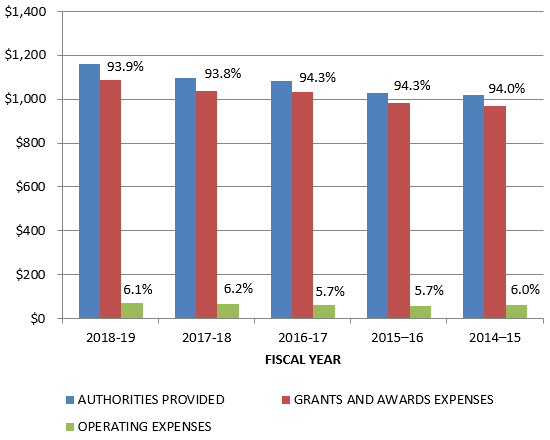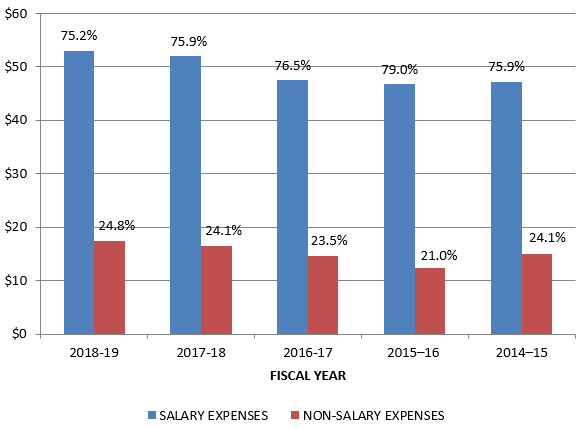Canadian Institutes of Health Research Annual Report 2018–19
Contents
- Vice-Chair’s Message
- Providing Stewardship and Accountability
- Financial Statement Discussion and Analysis
- Auditors’ Report and Financial Statements
Vice-Chair’s Message

Dr. Alice Aiken
Vice-Chair of the Governing Council of the Canadian Institutes of Health Research
On behalf of the Governing Council, I am pleased to present the 2018-19 Annual Report of the Canadian Institutes of Health Research (CIHR), the Government of Canada’s health research funding agency.
I am honoured to have served as Vice-Chair of CIHR’s Governing Council since July 2018. This past year has been a period of significant transformation for CIHR, with transitions in senior leadership and governance structures. I am confident that this renewal will further strengthen our relationship with all of our research partners as we work towards realizing the vision for the CIHR that is embodied in the CIHR Act.
CIHR assumed a major organizational change in terms of governance this past year including a transition of senior leadership bringing welcome stability to the organization after a year and a half of interim leadership. In late 2018, CIHR welcomed a new President, a new Vice-President, Research Programs, and new Governing Council members. Additionally, the separation of the role of the President of CIHR and that of the Chair of Governing Council by an amendment to the CIHR Act in June 2018 further supports our commitment to continuous improvement and accountability to Canadians. In the context of these transitions, CIHR has recently launched a two-year strategic and operational renewal of its governance approaches. This effort is intended to address how the organization is organized to effectively and efficiently make decisions and to engage in implementation and oversight. By strengthening the existing governance foundation and implementing governance best practices, CIHR will be positioned to achieve better outcomes, and restore and maintain the confidence in its work.
In its continued commitment towards enabling better support for research communities, CIHR collaborated with federal colleagues to advance the evidence-based policy agenda of the Government of Canada. In particular, it has supported the development of key government initiatives, including the Post-Traumatic Stress Injuries action plan, the pan-Canadian Antimicrobial Resistance action plan and the national Dementia Strategy; and has provided evidence to support the response to the opioid crisis, the legalization of cannabis and the safety and efficacy of vaping products.
CIHR also remained committed to further harmonizing a broad range of initiatives across the federal granting agencies. Through the Canada Research Coordinating Committee (CRCC) – created in October 2017, as recommended by Canada’s Fundamental Science Review – CIHR also collaborated on the harmonization of action plans for equity, diversity and inclusion, as well as early career researchers, to enable fair access, equitable participation and evidence-based decision-making. It also led to the creation of the New Frontiers in Research Fund in December 2018, through which the Government of Canada will better support research on interdisciplinary, international, high-risk and fast-breaking issues. The CRCC’s first annual report highlights many of these achievements and more. CIHR has also collaborated with its sister research funding agencies, the Natural Sciences and Engineering Research Council and the Social Sciences and Humanities Research Council, to coordinate efforts within and across the agencies to better support fundamental research. An outcome of these efforts is the Gateway initiative – currently in its discovery phase – which aims to develop a single solution to modernize our respective grants management systems, reduce the administrative burden on users, and improve service delivery and efficiency.
In alignment with its mandate, CIHR also launched several critical research initiatives to address key issues to facilitate the creation of new knowledge. In terms of investments in research, CIHR and several partners are collaborating to address the digital health challenge put to the Minister of Health in her mandate letter. This has led to a multi-year investment in the groundbreaking Strategy for Patient-Oriented Research Canadian Data Platform. This platform is a single portal through which researchers will be able to request access to a multitude of administrative, clinical, and social data from various sources from across the country. The new data platform will help foster an environment where researchers can address questions that cross boundaries and more easily build on the work of their peers, leading to the kinds of advances that improve our health and strengthen our health care system.
As you know, Canadian health systems are organized in a way that requires individuals to receive health services from a number of care providers, in a number of locations, leading to multiple transitions in care over time. This is especially true for individuals experiencing changes to their health status, as they grow older, experiencing a change in care need and/or a change in their location of care. In response, CIHR launched, in 2018, an initiative to support research that transforms the health system to optimize the outcomes of individuals experiencing Transitions in Care. This will help facilitate successful care transitions, thereby reducing susceptibility to fragmentation in care, poor quality of care, unfavorable experiences, compromised patient safety, and adverse medical events.
CIHR continues to make significant progress towards the Action Plan: Building a healthier future for First Nations, Inuit, and Métis Peoples, which commits CIHR to implement a series of concrete actions to further strengthen Indigenous health research in Canada. In this past year, CIHR organized two important events at the 2018 Indigenous Health Conference, a plenary session to raise awareness of existing challenges in Indigenous health research, and a workshop to integrate perspectives from the Truth and Reconciliation of Canada report, the United Nations Declaration on the Rights of Indigenous Peoples, and the 2017 Fundamental Science Review report. This past year also saw the launch of new initiatives to support the government’s Pan-Canadian Framework on Clean Growth and Climate Change and address food insecurity among Northern Indigenous Peoples.
On the international front, CIHR has continued to advance its engagement and collaboration with key partners and stakeholders. In many cases, our efforts go further when working in collaboration with counterparts around the world who are facing the same health and scientific challenges we are here in Canada. CIHR has continued to participate in international consortia, for example under the European Horizon 2020 framework programme, to address shared challenges such as dementia, antimicrobial resistance and rare diseases. CIHR is also part of a new agreement with United Kingdom Research and Innovation that has enabled new initiatives on artificial intelligence and diabetes and, along with Canadian partners, showed tremendous international leadership in 2018 by launching a rapid research response to the emerging Ebola outbreak in West Africa.
In acknowledgement of the impact of research, Budget 2018 proposed an investment of $354.7 million over five years (with $90.1 million per year ongoing) to increase CIHR’s support for fundamental research. These investments will help provide the research evidence needed to inform healthcare decisions, support a new generation of researchers and build a science community that looks more like Canada – more diverse and with a greater number of women.
Finally, in the short period of time that new leadership has been in place, a clear path has been identified to engage with the research community and other stakeholders in a national dialogue on the future of health research in Canada. This will represent a collective effort to define a vision for Canada’s health research funding ecosystem – a vision that would allow us to create a healthier future for Canadians, for generations to come. The findings from this dialogue will inform the new Strategic Plan for CIHR which will be launched in the summer of 2020 to coincide with CIHR’s 20th anniversary.
Under the President’s direction and the oversight of Governing Council, CIHR will deliver on the Strategic Plan in the coming years. We look forward to the elaboration of a long term, shared vision for an integrated health research ecosystem.
I invite you to read the financial details of this report and to learn more about how CIHR plays a leading role in supporting new scientific knowledge and enabling its translation into improved health, more effective health services and products, and a strengthened Canadian health care system.
Sincerely,
Professor Alice B. Aiken, PhD
Vice-Chair – Governing Council
Providing Stewardship and Accountability
CIHR Governing Council
CIHR reports to Parliament through the Minister of Health. Its Governing Council comprises a group of up to 18 distinguished Canadians who together provide oversight and strategic direction for the organization and evaluate its overall performance.

Alice B. Aiken
Vice-Chair, Governing Council
Vice President (Research)
Dalhousie University

Paul Allison
Faculty of Dentistry
McGill University

Brenda Andrews
Charles H. Best Chair of Medical Research
University Professor and Director
Donnelly Centre for Cellular and Biomolecular Research

Mark S. Dockstator
President
First Nations University of Canada

Diane Gosselin
President and Chief Executive Officer
CQDM

Nada Jabado
Senior Scientist, RI-MUHC, Glen site
Child Health and Human Development Program

Simon Kennedy
(Ex-officio, non-voting member)
Deputy Minister
Health Canada

Josette-Renée Landry
Founder and CEO of Streamline Genomics
Vice-President, Business Development Mitacs

Louise Lemieux-Charles
Professor Emeritus
Institute of Health Policy, Management and Evaluation
Dalla Lana School of Public Health
University of Toronto

Amélie Quesnel-Vallée
Associate Professor
Departments of Sociology & Epidemiology
McGill University

Michael Salter
Chief of Research and Senior Scientist
Neurosciences and Mental Health
The Hospital for Sick Children

Jeannie Shoveller
Professor
School of Population & Public Health
University of British Columbia

Michael Strong
(Ex-officio, non-voting member)
President, CIHR

Marcello Tonelli
Senior Associate Dean (Health Research)
Associate Vice President (Health Research)
Cumming School of Medicine
Financial Statement Discussion and Analysis
Introduction
The following Financial Statement Discussion and Analysis (FSD&A) should be read in conjunction with the Canadian Institutes of Health Research (CIHR) audited financial statements and accompanying notes for the year ended March 31, 2019.
The responsibility for the integrity and objectivity of the FSD&A rests with the management of CIHR. The purpose of the FSD&A is to highlight information and provide explanations to enhance the user’s understanding of CIHR’s financial position and results of operations, while demonstrating CIHR’s accountability for its resources. Additional information on CIHR’s performance is available in the CIHR Departmental Results Report, and information on its plans and priorities is available in the CIHR Department Plan.
Overview
The Canadian Institutes of Health Research was established in June 2000 under the Canadian Institutes of Health Research Act. It is listed in Schedule II to the Financial Administration Act as a departmental corporation. CIHR’s objective is to excel, according to international standards of scientific excellence, in the creation of new knowledge, and its translation into improved health, more effective health services and products, and a strengthened Canadian health care system.
CIHR’s budget is allocated through authorities approved by Parliament. CIHR has separate voted authorities for operating expenses and for grants/awards. Authorities provided to CIHR by Parliament do not parallel financial reporting according to Canadian public sector accounting standards, since authorities are primarily based on cash accounting principles. Consequently, items recognized in the Statement of Financial Position, the Statement of Operations and Departmental Net Financial Position, the Statement of Change in Departmental Net Debt, and the Statement of Cash Flows are not necessarily the same as those provided through authorities from Parliament. Note 3 of the Financial Statements provides users with a reconciliation between the two bases of reporting.
Highlights
As evidenced below, CIHR’s financial results in 2018-19 are consistent with those of the preceding fiscal year.
1. Statement of Financial Position
| As at March 31 | % Change | 2019 | 2018 |
|---|---|---|---|
| Total liabilities | (6.3%) | $13.4 | $14.3 |
| Total financial and non-financial assets | (3.6%) | $19.0 | $19.7 |
The slight decrease in total liabilities of $0.9 million is primarily due to a large grant payable in the 2017-18 accounts payable – external parties with a balance of $1.9 million that cleared in 2018-19. This decrease was offset by increases in accrued salaries and wages and vacation and compensatory pay liabilities ($0.7 million and $0.4 million respectively).
The balance in total financial and non-financial assets decreased by $0.7 million over the prior year. This was the result of a decrease in the due from the consolidated revenue fund of $1.2 million and a decrease in prepaid expenses of $0.2 million. The decreases were offset by a $0.5 million increase to accounts receivable – external parties resulting from grant refunds owing at the end of 2018-19, a $0.1 million increase to account receivable – other government departments and agencies and a $0.1 million increase to tangible capital assets.
2. Statement of Operations and Departmental Net Financial Position
| For the year ended March 31 | % Change | 2019 | 2018 |
|---|---|---|---|
| Total expenses | 4.7% | $1,159.4 | $1,107.3 |
| Net cost of operations before government funding and transfers | 5.1% | $1,155.2 | $1,099.5 |
The increase in both total expenses (4.7%) and in net cost of operations before government funding and transfers (5.1%) are attributable to increased Parliamentary authorities provided to CIHR by the Government of Canada of $56.5 million compared to the prior fiscal year.
3. Variance Analysis
3.1 Variances between current year actual results and budget
As noted, CIHR is funded by the Government of Canada through Parliamentary authorities. In 2018-19, CIHR’s Parliamentary authorities increased beyond the 2018-19 Main Estimates by $56.5 million throughout the fiscal year via Supplementary Estimates and other adjustments, as follows:
| 2018-19 Main Estimates (in millions of dollars) | $1,102.4 |
|---|---|
| Budget 2018Footnote * | 54.2 |
| Treasury Board Secretariat (TBS) salary reimbursements | 1.5 |
| Net transfers from other government departments | 0.5 |
| 2017-18 Operating budget carry-forward | 0.3 |
| Total increase in Parliamentary authorities | 56.5 |
| 2018-19 Year-end Parliamentary authorities | $1,158.9 |
|
|
CIHR’s 2018-19 year-end Parliamentary authorities of $1,158.9 million represent an increase of $60.5 million (or 5.5%) compared to CIHR’s year-end authorities in 2017-18 ($1,098.4 million). This increase is a key factor to note when comparing current year and prior year results for CIHR. The majority of the increase is due to the additional authorities received in 2018-19 as noted above.
3.2 Variances between current year actual results and prior year actual results
| For the year ended March 31 | % Change | 2019 | 2018 |
|---|---|---|---|
| Grants and awards | 4.8% | $1,088.9 | $1,038.8 |
| Total operating expenses | 2.9% | $70.5 | $68.5 |
Grants and awards expenses increased by 4.8% (or $50.1 million) in 2018-19 due to increased Parliamentary authorities provided to CIHR for grants (as outlined in section 3.1). Total operating expenses also increased by 2.9% ($2.0 million) over the previous year. This increase was mainly due to a 2% ($1.0 million) increase in salaries and employee benefits resulting from an anticipated economic increase to the 2018-19 salary ranges not yet formally approved. Rentals expenses increased by 17% ($0.2 million) and furniture, equipment and software expenses increased by 61% ($0.4 million) due to timing of prepaid invoice payments. Amortization expense also increased by 43% ($0.5 million) due to higher capital asset acquisitions over the past few years. These increases were offset by small fluctuations in other expense categories.
4. Trend Analysis
4.1. Grants and Awards Expenses (in millions of dollars)

Grants and Awards Expenses – Long Description
| 2018-19 | 2017-18 | 2016-17 | 2015–16 | 2014–15 | |
|---|---|---|---|---|---|
| Authorities provided | $1,158.9 | $1,098.4 | $1,083.2 | $1,028.3 | $1,018.0 |
| Grants and awards expenses | $1,088.9 | $1,038.8 | $1,031.1 | $980.6 | $967.5 |
| Operating expenses | $70.5 | $68.5 | $62.1 | $59.1 | $62.2 |
| Percentage grants and awards | 93.9% | 93.8% | 94.3% | 94.3% | 94.0% |
| Percentage operating expenses | 6.1% | 6.2% | 5.7% | 5.7% | 6.0% |
- As evidenced by the above chart, the proportion of grants and awards expenses in relation to changes in the Parliamentary authorities increase or decrease on a yearly basis.
- In 2018-19, grants and awards expenses made up 93.9% of total expenses, as compared to 93.8% in 2017-18.
4.2. Operating Expenses (in millions of dollars)

Operating Expenses – Long Description
| 2018-19 | 2017-18 | 2016-17 | 2015–16 | 2014–15 | |
|---|---|---|---|---|---|
| Salary expenses | $53.0 | $52.0 | $47.5 | $46.7 | $47.2 |
| Non-salary expenses | $17.5 | $16.5 | $14.6 | $12.4 | $15.0 |
| Total | 70.5 | 68.5 | 62.1 | 59.1 | 62.2 |
| Percentage salary expenses | 75.2% | 75.9% | 76.5% | 79.0% | 75.9% |
| Percentage non-salary expenses | 24.8% | 24.1% | 23.5% | 21.0% | 24.1% |
- Salary and employee benefit expenses increased by $1.0 million (or 1.9%) in 2018-19.
- In 2018-19, salaries and employee benefits made up 75.2% of total operating expenses, as compared to 75.9% in the prior year.
- Total operating expenses incurred were higher than those incurred in 2017-18.
- The ratio of operating expenses to total expenses was 6.1% in 2018-19, as compared to 6.2% in 2017-18.
Financial Outlook – 2019-20
Budget 2018 provided historic levels of new funding to reinvigorate Canada's research system, including the single largest investment in fundamental science in Canadian history. It also committed to ensuring that Canada's next generation of researchers—including students, trainees and early-career researchers—is more diverse.
To allow them to focus fully on their research, students receiving federal research grants or scholarships may not be participating in the traditional labour market. As there is no typical employer-employee relationship, student researchers are unable to take advantage of parental leave benefits offered under the Employment Insurance program.
To further improve equity, diversity and inclusion in the research system, Budget 2019 proposed to provide a total of $14.2 million over five years, starting in 2019–20, and $3.3 million per year ongoing, to CIHR, to expand parental leave coverage from six months to 12 months for students and postdoctoral fellows who receive granting council funding.
Additionally, Budget 2019 proposed to increase its investment in graduate students by creating more master’s level and doctoral scholarship awards through the Canada Graduate Scholarship program run by the three granting councils (CIHR, the Natural Sciences and Engineering Research Council, and the Social Sciences and Humanities Research Council). As a result, CIHR was allocated $31.9 million over five years, starting in 2019-20, and $7.4 million per year ongoing, to help more students access graduate studies.
Financial Statements
Canadian Institutes of Health Research
Statement of Management Responsibility Including Internal Control over Financial Reporting
Responsibility for the integrity and objectivity of the accompanying financial statements for the year ended March 31, 2019, and all information contained in these financial statements rests with the management of the Canadian Institutes of Health Research (CIHR). These financial statements have been prepared by management using the Government of Canada’s accounting policies, which are based on Canadian public sector accounting standards.
Management is responsible for the integrity and objectivity of the information in these financial statements. Some of the information in the financial statements is based on management's best estimates and judgment, and gives due consideration to materiality. To fulfill its accounting and reporting responsibilities, management maintains a set of accounts that provides a centralized record of CIHR’s financial transactions. Financial information submitted in the preparation of the Public Accounts of Canada, and included in CIHR’s Departmental Results Report, is consistent with these financial statements.
Management is also responsible for maintaining an effective system of internal control over financial reporting (ICFR) designed to provide reasonable assurance that financial information is reliable, that assets are safeguarded and that transactions are properly authorized and recorded in accordance with the Financial Administration Act and other applicable legislation, regulations, authorities and policies.
Management seeks to ensure the objectivity and integrity of data in its financial statements through careful selection, training and development of qualified staff; through organizational arrangements that provide appropriate divisions of responsibility; through communication programs aimed at ensuring that regulations, policies, standards and managerial authorities are understood throughout CIHR; and through conducting an annual risk-based assessment of the effectiveness of the system of ICFR.
The system of ICFR is designed to mitigate risks to a reasonable level based on an ongoing process to identify key risks, to assess effectiveness of associated key controls, and to make any necessary adjustments.
A risk-based assessment of the system of ICFR for the year ended March 31, 2019 was completed in accordance with the Treasury Board Policy on Financial Management and the results and action plans are summarized in the annexFootnote 1.
The effectiveness and adequacy of CIHR’s system of internal control is reviewed by the work of internal audit staff who conduct periodic audits of different areas of CIHR’s operations, and by CIHR’s Audit Committee, which oversees management’s responsibilities for maintaining adequate control systems and the quality of financial reporting, and which recommends the financial statements to the President of CIHR and its Governing Council.
Ernst & Young LLP, the independent auditor for CIHR, has expressed an opinion on the fair presentation of the financial statements of CIHR which does not include an audit opinion on the annual assessment of the effectiveness of CIHR’s internal controls over financial reporting.
Approved by:
Michael J. Strong, MD, FRCPC, FAAN, FCAHS
President
Dalia Morcos Fraser, CPA, CMA
Chief Financial Officer
Ottawa, Canada
June 19, 2019
Independent Auditors’ Report
To the Members of the Governing Council
Canadian Institutes of Health Research
Opinion
We have audited the financial statements of the Canadian Institutes of Health Research [the “Organization”], which comprise the statement of financial position as at March 31, 2019, and the statement of operations and departmental net financial position, statement of change in departmental net debt, and statement of cash flows for the year then ended, and notes to the financial statements, including a summary of significant accounting policies.
In our opinion, the accompanying financial statements present fairly, in all material respects the financial position of the Organization as at March 31, 2019, and its results of operations and departmental net financial position and its cash flows for the year then ended in accordance with Canadian public sector accounting standards.
Basis for opinion
We conducted our audit in accordance with Canadian generally accepted auditing standards. Our responsibilities under those standards are further described in the Auditor’s responsibilities for the audit of the financial statements section of our report. We are independent of the Organization in accordance with the ethical requirements that are relevant to our audit of the financial statements in Canada, and we have fulfilled our other ethical responsibilities in accordance with these requirements. We believe that the audit evidence we have obtained is sufficient and appropriate to provide a basis for our opinion.
Responsibilities of management and those charged with governance for the financial statements
Management is responsible for the preparation and fair presentation of the financial statements in accordance with Canadian public sector accounting standards, and for such internal control as management determines is necessary to enable the preparation of financial statements that are free from material misstatement, whether due to fraud or error.
In preparing the financial statements, management is responsible for assessing the Organization’s ability to continue as a going concern, disclosing, as applicable, matters related to going concern and using the going concern basis of accounting unless management either intends to liquidate the Organization or to cease operations, or has no realistic alternative but to do so.
Those charged with governance are responsible for overseeing the Organization’s financial reporting process.
Auditor’s responsibilities for the audit of the financial statements
Our objectives are to obtain reasonable assurance about whether the financial statements as a whole are free from material misstatement, whether due to fraud or error, and to issue an auditor’s report that includes our opinion. Reasonable assurance is a high level of assurance, but is not a guarantee that an audit conducted in accordance with Canadian generally accepted auditing standards will always detect a material misstatement when it exists. Misstatements can arise from fraud or error and are considered material if, individually or in the aggregate, they could reasonably be expected to influence the economic decisions of users taken on the basis of these financial statements.
As part of an audit in accordance with Canadian generally accepted auditing standards, we exercise professional judgment and maintain professional skepticism throughout the audit. We also:
- Identify and assess the risks of material misstatement of the financial statements, whether due to fraud or error, design and perform audit procedures responsive to those risks, and obtain audit evidence that is sufficient and appropriate to provide a basis for our opinion. The risk of not detecting a material misstatement resulting from fraud is higher than for one resulting from error, as fraud may involve collusion, forgery, intentional omissions, misrepresentations, or the override of internal control.
- Obtain an understanding of internal control relevant to the audit in order to design audit procedures that are appropriate in the circumstances, but not for the purpose of expressing an opinion on the effectiveness of the Organization’s internal control.
- Evaluate the appropriateness of accounting policies used and the reasonableness of accounting estimates and related disclosures made by management.
- Conclude on the appropriateness of management’s use of the going concern basis of accounting and, based on the audit evidence obtained, whether a material uncertainty exists related to events or conditions that may cast significant doubt on the Organization’s ability to continue as a going concern. If we conclude that a material uncertainty exists, we are required to draw attention in our auditor’s report to the related disclosures in the financial statements or, if such disclosures are inadequate, to modify our opinion. Our conclusions are based on the audit evidence obtained up to the date of our auditor’s report. However, future events or conditions may cause the Organization to cease to continue as a going concern.
- Evaluate the overall presentation, structure, and content of the financial statements, including the disclosures, and whether the financial statements represent the underlying transactions and events in a manner that achieves fair presentation.
We communicate with those charged with governance regarding, among other matters, the planned scope and timing of the audit and significant audit findings, including any significant deficiencies in internal control that we identify during our audit.
Ernst & Young LLP
Chartered Professional Accounts
Licensed Public Accountants
Ottawa, Canada,
June 19, 2019
Canadian Institutes of Health Research
Statement of Financial Position
As at March 31
(in thousands of dollars)
| 2019 | 2018 | |
|---|---|---|
| Liabilities | ||
| Accounts payable and accrued liabilities (note 4) | $6,911 | $8,029 |
| Vacation pay and compensatory leave | 3,015 | 2,613 |
| Deferred revenue (note 5) | 2,821 | 2,899 |
| Employee future benefits (note 6) | 687 | 740 |
| Total liabilities | 13,434 | 14,281 |
| Financial assets | ||
| Due from the Consolidated Revenue Fund | 9,733 | 10,924 |
| Accounts receivable and advances (note 7) | 1,745 | 1,168 |
| Total financial assets | 11,478 | 12,092 |
| Departmental net debt | 1,956 | 2,189 |
| Non-financial assets | ||
| Prepaid expenses | 333 | 555 |
| Tangible capital assets (note 8) | 7,157 | 7,053 |
| Total non-financial assets | 7,490 | 7,608 |
| Departmental net financial position | $5,534 | $5,419 |
|
Contractual obligations (note 9) The accompanying notes form an integral part of these financial statements. |
||
Approved by:
Michael J. Strong, MD, FRCPC, FAAN, FCAHS
President
Dalia Morcos Fraser, CPA, CMA
Chief Financial Officer
Ottawa, Canada
June 19, 2019
Canadian Institutes of Health Research
Statement of Operations and Departmental Net Financial Position
For the Year Ended March 31
(in thousands of dollars)
| 2019 | 2019 | 2018 | |
|---|---|---|---|
| Planned Results (note 2) |
|||
| Expenses | |||
| Funding health research and training | $1,076,450 | $1,122,040 | $1,075,394 |
| Internal Services | 32,847 | 37,358 | 31,952 |
| Total expenses | 1,109,297 | 1,159,398 | 1,107,346 |
| Revenues | |||
| Funding health research and training | 5,648 | 4,238 | 7,822 |
| Total revenues | 5,648 | 4,238 | 7,822 |
| Net cost of operations before government funding and transfers | $1,103,649 | $1,155,160 | $1,099,524 |
| Government funding and transfers | |||
| Net cash provided by Government | 1,149,067 | 1,090,506 | |
| Change in Due from the Consolidated Revenue Fund | (1,191) | 675 | |
| Services provided without charge by other government departments (note 11) | 7,399 | 7,643 | |
| Net cost of operations after government funding and transfers | (115) | (700) | |
| Departmental net financial position – beginning of year | 5,419 | 6,119 | |
| Departmental net financial position – end of year | $5,534 | $5,419 | |
|
Segmented information (note 12) The accompanying notes form an integral part of these financial statements. |
|||
Canadian Institutes of Health Research
Statement of Change in Departmental Net Debt
For the Year Ended March 31
(in thousands of dollars)
| 2019 | 2018 | |
|---|---|---|
| Net cost of operations after government funding and transfers | $(115) | $700 |
| Change due to tangible capital assets | ||
| Acquisition of tangible capital assets | 1,959 | 1,762 |
| Amortization of tangible capital assets | (1,801) | (1,258) |
| Loss on disposal of capital assets | (54) | - |
| Total change due to tangible capital assets | 104 | 504 |
| Change due to prepaid expenses | (222) | 58 |
| Net (decrease) / increase in departmental net debt | (233) | 1,262 |
| Departmental net debt – beginning of year | 2,189 | 927 |
| Departmental net debt – end of year | $1,956 | $2,189 |
|
The accompanying notes form an integral part of these financial statements. |
||
Canadian Institutes of Health Research
Statement of Cash Flows
For the Year Ended March 31
(in thousands of dollars)
| 2019 | 2018 | |
|---|---|---|
| Operating activities | ||
| Net cost of operations before government funding and transfers | $1,155,160 | $1,099,524 |
| Non-cash items: | ||
| Amortization of tangible capital assets | (1,801) | (1,258) |
| Services provided without charge by other government departments (note 11) | (7,399) | (7,643) |
| Loss on disposal of capital assets | (54) | - |
| Variations in Statement of Financial Position: | ||
| Increase / (decrease) in accounts receivable and advances | 577 | (1,219) |
| (Decrease) / increase in prepaid expenses | (222) | 58 |
| Decrease / (increase) in accounts payable and accrued liabilities | 1,118 | (1,789) |
| (Increase) in vacation pay and compensatory leave | (402) | (188) |
| Decrease in deferred revenue | 78 | 1,114 |
| Decrease in future employee benefits | 53 | 145 |
| Cash used in operating activities | 1,147,108 | 1,088,744 |
| Capital investing activities | ||
| Acquisitions of tangible capital assets | 1,959 | 1,762 |
| Cash used in Capital investing activities | 1,959 | 1,762 |
| Net cash provided by Government of Canada | $1,149,067 | $1,090,506 |
|
The accompanying notes form an integral part of these financial statements. |
||
Canadian Institutes of Health Research
Notes to the Financial Statements
For the Year Ended March 31, 2019
(in thousands of dollars)
1. Authority and objectives
The Canadian Institutes of Health Research (CIHR) was established in June 2000 under the Canadian Institutes of Health Research Act, replacing the former Medical Research Council of Canada. It is listed in Schedule II to the Financial Administration Act as a departmental corporation.
CIHR’s objective is to excel, according to international standards of scientific excellence, in the creation of new knowledge, and its translation into improved health, more effective health services and products, and a strengthened Canadian health care system. CIHR’s strategic outcome is as follows: Canada is a world leader in the creation, dissemination and application of health research knowledge. The strategic outcome is achieved based on two programs. The first program is Investigator-Initiated Health Research, to develop and support a well-trained base of world-class health researchers and trainees conducting research across all aspects of health, including biomedical research, clinical research, research respecting health systems, health services, the health of populations, societal and cultural dimensions of health and environmental influences on health, and other research as required. The goal of the Investigator-Initiated Health Research program is to advance health knowledge and to apply this knowledge in order to improve health systems and/or health outcomes. The second program is Priority-Driven Health Research, which provides funding to researchers for emergent and targeted research that responds to the changing health needs and priorities of Canadians across all aspects of health, including biomedical research, clinical research, research respecting health systems, health services, the health of populations, societal and cultural dimensions of health and environmental influences on health, and other research as required. The goal of the Priority-Driven Health Research program is to advance health knowledge and its application, in specific areas of research identified by CIHR in consultation with other government departments, partners and stakeholders, in order to improve health systems and/or health outcomes in these priority areas.
CIHR is governed by a Governing Council of up to 18 members appointed by the Governor in Council. Sixteen members, including the Chair, are voting members, and 2 are non-voting, ex officio members: the Deputy Minister and the President of CIHR. The Governing Council sets overall strategic direction, goals and policies and oversees programming, resource allocation, ethics, budget, planning and accountability.
CIHR has thirteen institutes that focus on identifying the research needs and priorities for specific health areas, or for specific populations, then developing strategic initiatives to address those needs. Each institute is led by a Scientific Director who is guided by an Institute Advisory Board, which strives to include representation of the public, researcher communities, research funders, health professionals, health policy specialists and other users of research results.
CIHR’s grants, awards and operating expenditures are funded by budgetary authorities. Employee benefits are funded by statutory authorities.
2. Summary of significant accounting policies
These financial statements are prepared using CIHR’s accounting policies stated below, which are based on Canadian public sector accounting standards. The presentation and results using the stated accounting policies do not result in any significant differences from Canadian public sector accounting standards.
Significant accounting policies are as follows:
Parliamentary authorities
CIHR is financed by the Government of Canada through Parliamentary authorities. Financial reporting of authorities provided to CIHR do not parallel financial reporting according to generally accepted accounting principles since authorities are primarily based on cash flow requirements. Consequently, items recognized in the Statement of Operations and Departmental Net Financial Position and the Statement of Financial Position are not necessarily the same as those provided through authorities from Parliament. Note 3 provides a reconciliation between the bases of reporting. The planned results amounts in the “Expenses” and “Revenues” sections of the Statement of Operations and Departmental Net Financial Position are the amounts reported in the Future-oriented Statement of Operations (unaudited) included in the 2018-19 Departmental Plan. Planned results are not presented in the “Government funding and transfers” section of the Statement of Operations and Departmental Net Financial Position and in the Statement of Change in Departmental Net Debt because these amounts were not included in the 2018-19 Departmental Plan.
Net cash provided by Government
CIHR operates within the Consolidated Revenue Fund (CRF), which is administered by the Receiver General for Canada. All cash received by CIHR is deposited to the CRF and all cash disbursements made by CIHR are paid from the CRF. The net cash provided by Government is the difference between all cash receipts and all cash disbursements, including transactions between departments of the Government.
Amounts due from the Consolidated Revenue Fund (CRF)
Amounts due from CRF are the result of timing differences at year-end between when a transaction affects authorities and when it is processed through the CRF. Amounts due from the CRF represent the net amount of cash that CIHR is entitled to draw from the CRF without further authorities to discharge its liabilities.
Revenues
Funds received from external parties for specified purposes are recorded upon receipt as deferred revenue. Revenues are then recognized in the period in which the related expenses are incurred.
Deferred revenue consists of amounts received in advance of the delivery of goods and rendering of services that will be recognized as revenue in a subsequent fiscal year as it is earned.
Other revenues are recognized in the period the event giving rise to the revenues occurred.
Refunds of previous years' expenses
These amounts include the return of grants and awards funds to CIHR in the current fiscal year for expenses incurred in previous fiscal years due to cancellations, refunds of previous years' expenses related to goods or services, and adjustments of previous years' accounts payable. These refunds and adjustments are recorded as revenue.
Expenses
Grants and awards (transfer payments) are recorded as an expense in the year the transfer is authorized and all eligibility criteria have been met by the recipient.
Vacation pay and compensatory leave are accrued as the benefits are earned by employees under their respective terms of employment.
Services provided without charge by other government departments for accommodation and employer contributions to the health and dental insurance plans are recorded as operating expenses at their carrying value.
Employee future benefits
- Pension benefits: Eligible employees participate in the Public Service Pension Plan (the Plan), a multiemployer defined benefit pension plan administered by the Government. CIHR’s contributions to the Plan are charged to expenses in the year incurred and represent the total departmental obligation to the Plan. CIHR’s responsibility with regard to the Plan is limited to its contributions. Actuarial surpluses or deficiencies are recognized in the financial statements of the Government of Canada, as the Plan’s sponsor.
- Severance benefits: The accumulation of severance benefits for voluntary departures ceased for applicable employee groups. The remaining obligation for employees who did not withdraw benefits is calculated on the retained accumulated weeks of severance at their current rate of pay as at March 31.
Accounts receivable and advances
Accounts receivable and advances are initially recorded at cost. When necessary, an allowance for valuation is recorded to reduce the carrying value of accounts receivables and advances to amounts that approximate their net recoverable value.
Tangible capital assets
The costs of acquiring land, buildings, equipment and other capital property are capitalized as tangible capital assets and, except for land, are amortized to expense over the estimated useful lives of the assets, as described in note 8. All tangible capital assets having an initial cost of $5,000 or more are recorded at their acquisition cost.
Contingent liabilities
Contingent liabilities are potential liabilities which may become actual liabilities when one or more future events occur or fail to occur. If the future event is likely to occur or fail to occur, and a reasonable estimate of the loss can be made, a provision is accrued and an expense recorded to other expenses. If the likelihood is not determinable or an amount cannot be reasonably estimated, the contingency is disclosed in the notes to the financial statements.
Related party transactions
- Inter-entity transactions are transactions between commonly controlled entities. CIHR is a component of the Government of Canada reporting entity and is therefore related to all federal departments, agencies and crown corporations. Inter-entity transactions are recorded on a gross basis and are measured at the carrying amount, except for the following:
- Services provided on a recovery basis are recognized as revenues and expenses on a gross basis and measured at the exchange amount.
- Goods or services received without charge between commonly controlled entities are recorded at the carrying value.
- Related parties include individuals who are members of key management personnel (KMP) or close family members of those individuals and entities controlled by, or under shared control of, a member of KMP or a close family member of that individual. KMP are individuals having the authority and responsibility for planning, directing and controlling the activities of CIHR. Related party transactions, other than inter-entity transactions, are recorded at the exchange value.
- Inter-entity transactions are transactions between commonly controlled entities. CIHR is a component of the Government of Canada reporting entity and is therefore related to all federal departments, agencies and crown corporations. Inter-entity transactions are recorded on a gross basis and are measured at the carrying amount, except for the following:
Measurement uncertainty
The preparation of these financial statements requires management to make estimates and assumptions that affect the reported and disclosed amounts of assets, liabilities, revenues and expenses reported in the financial statements and accompanying notes at March 31. The estimates are based on facts and circumstances, historical experience, general economic conditions and reflect CIHR’s best estimate of the related amount at the end of the reporting period. The most significant items where estimates are used are contingent liabilities, the liability for employee future benefits and the useful life of tangible capital assets. Actual results could significantly differ from those estimated. Management’s estimates are reviewed periodically and, as adjustments become necessary, they are recorded in the financial statements in the year they become known.
Adoption of new accounting standards
The Public Sector Accounting Board (PSAB) issued new accounting standard Restructuring transactions (PS 3430) effective for fiscal years beginning on or after April 1, 2018. CIHR adopted the new accounting standard and determined that it has no impact on CIHR’s financial statements or note disclosures.
3. Parliamentary authorities
CIHR receives most of its funding through annual Parliamentary authorities. Items recognized in the Statement of Operations and Departmental Net Financial Position and the Statement of Financial Position in one year may be funded through Parliamentary authorities in prior, current or future years. Accordingly, CIHR has different net results of operations for the year on a government funding basis than on an accrual accounting basis. The differences are reconciled in the following tables:
Reconciliation of net cost of operations to current year authorities used
2019 2018 Net cost of operations before government funding and transfers $1,155,160 $1,099,524 Adjustments for items affecting net cost of operations but not affecting authorities: Amortization of tangible capital assets (1,801) (1,258) Services provided without charge by other government departments (7,399) (7,643) Increase in vacation pay and compensatory leave (402) (188) Decrease in employee future benefits 53 145 Refunds of previous years' grants and awards 3,236 4,420 Bad debt expense 3 28 Loss on disposal of capital assets (54) - Other adjustments 394 313 (5,970) (4,183) Adjustments for items not affecting net cost of operations but affecting authorities: Acquisition of tangible capital assets 1,959 1,762 (Decrease) / increase in prepaid expenses (222) 58 1,737 1,820 Current year authorities used $1,150,927 $1,097,161 Authorities provided and used
2019 2018 Authorities provided: Vote 1 - Operating expenditures $57,880 $56,746 Vote 5 - Grants 1,095,042 1,035,848 Statutory amounts 6,039 5,775 Less: Authorities available for future years (876) (766) Frozen authorities (2,971) - Lapsed: Grants (4,187) (442) Current year authorities used $1,150,927 $1,097,161
4. Accounts payable and accrued liabilities
The following table presents details of CIHR's accounts payable and accrued liabilities:
| 2019 | 2018 | |
|---|---|---|
| Accounts payable - other government departments and agencies | $802 | $542 |
| Accounts payable - external parties | 512 | 2,636 |
| Total accounts payable | 1,314 | 3,178 |
| Accrued liabilities | 5,597 | 4,851 |
| Total accounts payable and accrued liabilities | $6,911 | $8,029 |
5. Deferred revenue
Deferred revenue represents the balance at year-end of unearned revenues stemming from amounts received from external parties that are restricted in order to fund the expenditures related to specific research projects and stemming from amounts received for fees prior to services being performed. Revenue is recognized in the period in which these expenditures are incurred or in which the service is performed. Details of the transactions related to this account are as follows:
| 2019 | 2018 | |
|---|---|---|
| Opening balance | $2,899 | $4,013 |
| Amounts received | 924 | 2,288 |
| Revenue recognized | (1,002) | (3,402) |
| Closing balance | $2,821 | $2,899 |
6. Employee future benefits
Pension benefits
CIHR’s employees participate in the Plan, which is sponsored and administered by the Government of Canada. Pension benefits accrue up to a maximum period of 35 years at a rate of 2 percent per year of pensionable service, times the average of the best five consecutive years of earnings. The benefits are integrated with the Canada/Québec Pension Plans benefits and they are indexed to inflation.
Both the employees and CIHR contribute to the cost of the Plan. Due to the amendment of the Public Service Superannuation Act following the implementation of provisions related to Economic Action Plan 2012, employee contributors have been divided into two groups – Group 1 relates to existing plan members as of December 31, 2012 and Group 2 relates to members joining the Plan as of January 1, 2013. Each group has a distinct contribution rate.
The 2018-19 expense amounts to $4,207 ($3,928 in 2017-18). For Group 1 members, the expense represents approximately 1.01 times (1.01 times in 2017-18) the employee contributions and, for Group 2 members, approximately 1.00 times (1.00 times in 2017-18) the employee contributions.
CIHR’s responsibility with regard to the Plan is limited to its contributions. Actuarial surpluses or deficiencies are recognized in the Consolidated Financial Statements of the Government of Canada, as the Plan’s sponsor.
Severance benefits
Severance benefits provided to CIHR’s employees were previously based on an employee’s eligibility, years of service and salary at termination of employment. However, since 2011 the accumulation of severance benefits for voluntary departures progressively ceased for substantially all employees. Employees subject to these changes were given the option to be paid the full or partial value of benefits earned to date or collect the full or remaining value of benefits upon departure from the public service. By March 31, 2019, all settlements for immediate cash out were completed. Severance benefits are unfunded and, consequently, the outstanding obligation will be paid from future authorities.
The changes in the obligations during the year were as follows:
2019 2018 Accrued benefit obligation – beginning of year $740 $885 Expense for the year 13 30 Benefits paid during the year (66) (175) Accrued benefit obligation – end of year $687 $740
7. Accounts receivable and advances
The following table presents details of CIHR’s accounts receivable and advances balances:
| 2019 | 2018 | |
|---|---|---|
| Accounts receivable - other government departments and agencies | $617 | $519 |
| Accounts receivable - external parties | 1,148 | 671 |
| Accountable advances | - | 1 |
| 1,765 | 1,191 | |
| Allowance for doubtful accounts receivable from external parties | (20) | (23) |
| Total accounts receivable from external parties | $1,745 | $1,168 |
8. Tangible capital assets
Amortization of tangible capital assets is done on a straight-line basis over the estimated useful life of the capital asset as follows:
| Asset class | Amortization period |
|---|---|
| Informatics hardware | 3–5 years |
| Informatics software | 3–10 years |
| Office equipment | 10 years |
| Vehicles | 5 years |
Assets under construction are not amortized until they become available for use.
| Cost | Accumulated amortization | Net book value | ||||||||
|---|---|---|---|---|---|---|---|---|---|---|
| Capital asset class |
Opening balance |
Acquisitions | Disposals and write-offs |
Closing balance |
Opening balance |
Amortization | Disposals and write-offs |
Closing balance |
2019 | 2018 |
| Informatics hardware | $1,699 | $386 | $(192) | $1,893 | $1,144 | $238 | $(192) | $1,190 | $703 | $555 |
| Informatics software | 19,626 | 1,229 | - | 20,855 | 13,650 | 1,547 | - | 15,197 | 5,658 | 5,976 |
| Office equipment | 150 | 12 | (34) | 128 | 83 | 15 | (27) | 71 | 57 | 67 |
| Vehicles | - | 30 | - | 30 | - | 1 | - | 1 | 29 | - |
| Assets under construction | 455 | 302 | (47) | 710 | - | - | - | - | 710 | 455 |
| Total | $21,930 | $1,959 | $(273) | $23,616 | $14,877 | $1,801 | $(219) | $16,459 | $7,157 | $7,053 |
9. Contractual obligations
The nature of CIHR’s activities may result in some large multi-year contracts and obligations whereby CIHR will be obligated to make future payments in order to carry out its grants and awards payment programs or when the services/goods are received. Significant contractual obligations that can be reasonably estimated are summarized as follows:
| Grants and awards | Operating expenditures | Total | |
|---|---|---|---|
| 2020 | $959,126 | $3,929 | $963,055 |
| 2021 | 735,495 | 157 | 735,652 |
| 2022 | 525,782 | 49 | 525,831 |
| 2023 | 319,374 | 44 | 319,418 |
| 2024 | 153,528 | 22 | 153,550 |
| 2025 and subsequent | 69,600 | - | 69,600 |
| Total | $2,762,905 | $4,201 | $2,767,106 |
10. Contingent liabilities
CIHR may be subject to claims and litigation in the normal course of business. In management's view, there are currently no such claims with a material impact on the financial statements and, consequently, no provision has been made.
11. Related party transactions
-
Common services provided without charge by other government departments
During the year, CIHR received services without charge from certain common service organizations related to accommodation and the employer’s contribution to the health and dental insurance plans. These services provided without charge are recorded at the carrying value in CIHR’s Statement of Operations and Departmental Net Financial Position as follows:
2019 2018 Accommodation $3,640 $3,654 Employer's contribution to the health and dental insurance plans 3,759 3,989 Total $7,399 $7,643 The Government has centralized some of its administrative activities for efficiency, cost-effectiveness purposes and economic delivery of programs to the public. As a result, the Government uses central agencies and common service organizations so that one department performs services for all other departments and agencies without charge. The costs of these services, such as the payroll and cheque issuance services provided by Public Services and Procurement Canada, are not included in CIHR’s Statement of Operations and Departmental Net Financial Position.
Administration of programs on behalf of other government departments
Under a memorandum of understanding signed with the Natural Sciences and Engineering Research Council (NSERC) and the Social Sciences and Humanities Research Council (SSHRC), CIHR administers funds for the Vanier Canada Graduate Scholarship and Banting Postdoctoral Fellowship programs. During the year, CIHR incurred expenses of $22,751 ($22,811 in 2017-18) for grants and awards on behalf of NSERC and SSHRC. These expenses are reflected in the financial statements of NSERC and SSHRC and are not recorded in these financial statements.
12. Segmented information
Presentation by segment is based on CIHR’s core responsibilities. The presentation by segment is based on the same accounting policies as described in the Summary of Significant Accounting Policies in note 2. The following table presents the expenses incurred and revenues generated for the main core responsibilities, by major object of expense and by major type of revenue. The segment results for the period are as follows:
| 2019 | 2018 | |||
|---|---|---|---|---|
| Funding health research and training | Internal Services | Total | Total | |
| Grants and awards | $1,088,886 | $- | $1,088,886 | $1,038,808 |
| Operating expenses | ||||
| Salaries and employee benefits | 26,292 | 26,723 | 53,015 | 52,012 |
| Professional and special services | 1,099 | 3,096 | 4,195 | 4,353 |
| Travel | 3,786 | 310 | 4,096 | 4,071 |
| Accomodation | 1,619 | 2,021 | 3,640 | 3,655 |
| Amortization of tangible capital assets | - | 1,802 | 1,802 | 1,258 |
| Rentals | 269 | 1,220 | 1,489 | 1,271 |
| Furniture, equipment and software | 10 | 1,026 | 1,036 | 644 |
| Communication | 73 | 908 | 981 | 1,035 |
| Utilities, materials and supplies | 6 | 132 | 138 | 138 |
| Other | - | 120 | 120 | 101 |
| Total operating expenses | 33,154 | 37,358 | 70,512 | 68,538 |
| Total expenses | 1,122,040 | 37,358 | 1,159,398 | 1,107,346 |
| Revenues | ||||
| Donations for health research | 1,002 | - | 1,002 | 3,402 |
| Refunds of previous years' grants and awards | 3,236 | - | 3,236 | 4,420 |
| Total revenues | 4,238 | - | 4,238 | 7,822 |
| Net cost from continuing operations | $1,117,802 | $37,358 | $1,155,160 | $1,099,524 |
13. Comparative information
Certain comparative figures have been reclassified to conform to the current year’s presentation.
- Date modified: